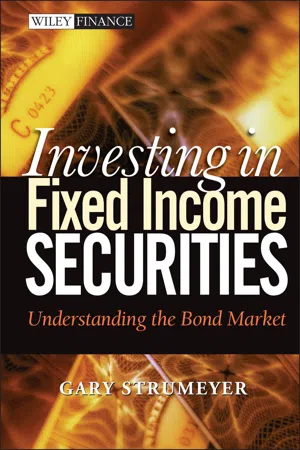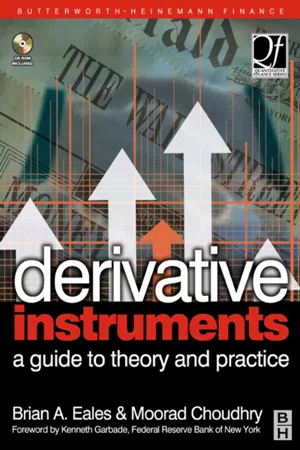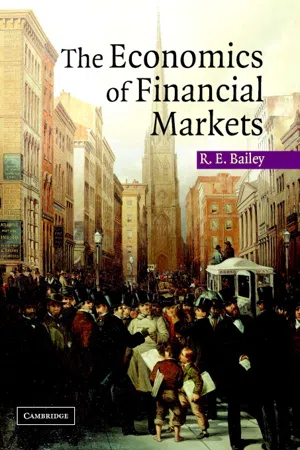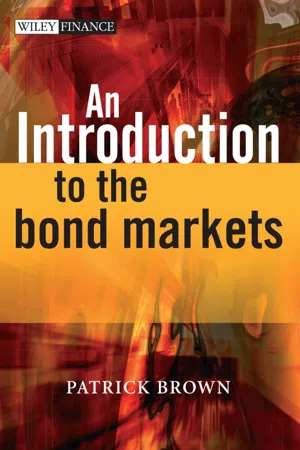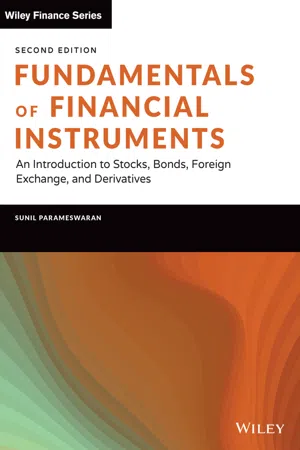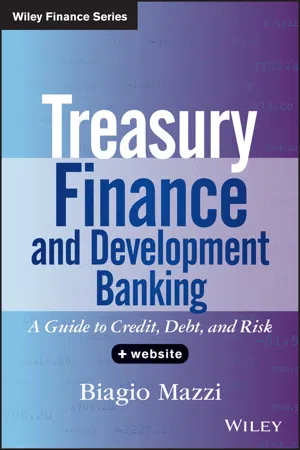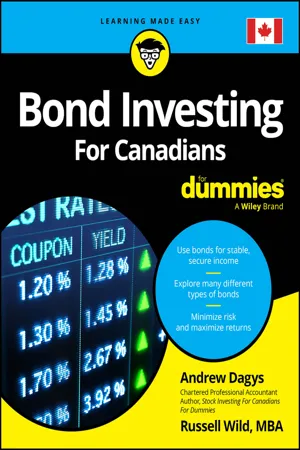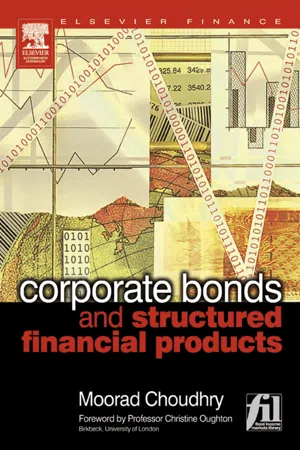Economics
Coupon Bond
A coupon bond is a type of debt security that pays periodic interest payments, known as coupons, to the bondholder. These payments are typically made semi-annually or annually. At maturity, the bondholder receives the face value of the bond. Coupon bonds are known for their fixed interest payments and are often used by corporations and governments to raise capital.
Written by Perlego with AI-assistance
Related key terms
1 of 5
11 Key excerpts on "Coupon Bond"
- eBook - ePub
Investing in Fixed Income Securities
Understanding the Bond Market
- Gary Strumeyer(Author)
- 2012(Publication Date)
- Wiley(Publisher)
Chapter 2
The Basics of Debt Instruments
Michael BrunoBefore we move ahead, we should become familiar with common terminology used in describing bonds. In the beginning, the term fixed income securities was used to describe any investment vehicle that paid a fixed rate of interest to the investor over a clearly defined period. While that term is still the one used today to describe a whole plethora of investment vehicles, the term fixed income is somewhat of a misnomer. Some securities provide a variable rate of interest to the investor. Others provide no interest payments at all.Regardless of whether they are called fixed income securities, debt instruments, debt obligations, or the more regularly used term bonds , all have certain elements in common. Your journey toward understanding the structure, valuation, and analysis of bonds begins now.COUPON RATE
The rate of interest promised to the purchaser of a bond by the bond’s issuer is called the coupon . Why is it called a coupon? Some readers may remember a time when bonds were issued in the form of paper certificates. These bearer bonds were considered the property of whoever physically possessed them. Attached to the bottom of these bonds were small coupons that entitled the bearer to the interest payments of the bond. The bearer, who was presumed to be the owner, would clip the coupon that represented the next interest payment and send it to the bond’s trustee . (See Chapter 11 for more information regarding the function of the trustee.) The trustee, usually a large commercial bank, would then mail a check for that interest payment to the bearer. Nowadays, virtually all bond ownership is computerized and interest payments are made automatically to the registered bond owner of record. However, the term coupon has persisted to this day.The coupon interest rate is the contractual interest rate paid for the life of the instrument and is stated as an annual rate. Usually, the coupon interest is paid in annual, semiannual, or quarterly installments and the specific dates are based on the bond’s final payment date, known as the maturity date - eBook - PDF
Derivative Instruments
A Guide to Theory and Practice
- Brian Eales, Moorad Choudhry(Authors)
- 2003(Publication Date)
- Butterworth-Heinemann(Publisher)
2 Overview of Fixed Income Securities In this chapter we present an introduction to fixed income analysis, particularly the pricing of default-free zero-coupon and coupon fixed-term bonds. Further reading is given in the bibliography. 1 2.1 Basic concepts We are familiar with two types of fixed income security, zero-Coupon Bonds , also known as discount bonds or strips , and Coupon Bonds . A zero-Coupon Bond makes a single payment on its maturity date, while a Coupon Bond makes regular interest payments at regular dates up to and including its maturity date. A Coupon Bond may be regarded as a set of strips, with each coupon payment and the redemption payment on maturity being equivalent to a zero-Coupon Bond maturing on that date. This is not a purely academic concept ± witness events before the advent of the formal market in US Treasury strips, when a number of investment banks had traded the cash flows of Treasury securities as separate zero-coupon securities. 2 Bonds are described by their issuer name, coupon rate and term to maturity, and those that have fixed coupons and fixed maturity terms are known as conventional or vanilla bonds. An example of the basic description of a bond is given in Figure 2.1, the Bloomberg ``DES'' page. The literature we review in this section is set in a market of default-free bonds, whether they are zero-Coupon Bonds or Coupon Bonds. The market is assumed to be liquid so that bonds may be freely bought and sold. Prices of bonds are determined by the economy-wide supply and demand for the bonds at any time, so they are macroeconomic and not set by individual bond issuers or traders. 1 Parts of this chapter first appeared in Choudhry (2001), Chapter 3. 2 These banks included Merrill Lynch, Lehman Brothers and Salomon Brothers, among others (Fabozzi, 1993). The term ``strips'' comes from Separate Trading of Registered Interest and Principal of Securities, the name given when the official market was introduced by the Treasury. - eBook - PDF
Fixed-Income Securities
Valuation, Risk Management and Portfolio Strategies
- Lionel Martellini, Philippe Priaulet, Stéphane Priaulet(Authors)
- 2005(Publication Date)
- Wiley(Publisher)
2.3 Taxonomy of Rates There are a host of types of interest rates involved in the fixed-income jargon. It is very impor- tant that you obtain a good understanding of the meaning of each concept before you move further along. 2.3.1 Coupon Rate and Current Yield The coupon rate is the stated interest rate on a security, referred to as an annual percentage of face value. It is commonly paid twice a year (in the United States, for example) or once a year (in France and Germany, for example). It is called the coupon rate because bearer bonds carry coupons for interest payments. Each coupon entitles the bearer to a payment when a set date has been reached. Today, most bonds are registered in holders’ names, and interest payments are sent to the registered holder, but the term coupon rate is still widely used. It is essentially used to obtain the cash flows and shall not be confused with the actual current yield. The current yield y c is obtained using the following formula y c = cN P where c is the coupon rate, N is the nominal value and P is the current price. Example 2.15 A $1,000 bond has an annual coupon rate of 7%, so it pays $70 a year. If you buy the bond for $900, your actual current yield is 7.78% = $70 $900 If you buy the bond for $1,100, the current yield is 6.36% = $70 $1,100 In any event, the 7% coupon rate does not change. 2.3.2 Yield to Maturity The yield to maturity (YTM) is the single rate that sets the present value of the cash flows equal to the bond price. More precisely, the bond price P is found by discounting future cash flows back to their present value as indicated in the two following formulas depending on the coupon frequency: 50 Fixed Income Securities • When we assume that coupons are paid semiannually P = 2T t =1 CF t 1 + y 2 2 t the yield denoted by y 2 is expressed on a yearly basis with semiannual compounding where 2T is the number of semiannual periods. - eBook - PDF
- Roy E. Bailey(Author)
- 2005(Publication Date)
- Cambridge University Press(Publisher)
With six-monthly instalments, 2 1 / 2 per cent of the face value is paid twice per year. Between the dates at which coupons are paid, the price at which a bond is traded is ‘dirty’, in the sense that the price reflects an element of accrued interest. It is 2 An annuity is a coupon-paying bond with face value equal to zero (i.e. m = 0); it provides a sequence of payments, c , that terminates at a specified date (or when a specified event, such as the death of the annuitant, occurs). 3 The label ‘consol’ is an abbreviation of ‘Consolidated Fund Stock’, first issued in the early 1750s. 4 Readers with long memories will recall the Goschen conversion of 1888, when British government stock with a coupon rate of 3 per cent was reduced to 2 1 / 2 % – see Palgrave’s Dictionary of Political Economy (Higgs, 1894, Vol. I, pp. 404–5). Another conversion was made in the early 1930s. 5 Coupons acquired their name from the practice of issuing bonds with attached tickets – ‘coupons’ – that holders would clip off on each stipulated date and present to the issuer in return for the amount due. Bond markets and fixed-interest securities 285 possible to estimate the implied value of accrued interest and to subtract it from the dirty price to obtain a clean price. In this chapter, all bond prices are assumed clean – i.e. a correction has been made to eliminate the effect of interest accrued since the last coupon payment. Zero-Coupon Bonds Also called ‘pure discount bonds’ or ‘bullet bonds’, zero-Coupon Bonds are those for which c = 0. They pay a lump sum, the bond’s face value, at maturity. Zero-Coupon Bonds play an important role in financial analysis, for reasons shortly to be explained. While zero-Coupon Bonds do exist (e.g. treasury bills, very short-term govern-ment debt), they are less commonly issued than theory might suggest. Given their importance in financial analysis, zero-Coupon Bonds are often created synthetically as stripped bonds , or ‘strips’. - eBook - PDF
- Patrick J. Brown(Author)
- 2006(Publication Date)
- Wiley(Publisher)
This could be a property and could be worth more than the capital lost. Many eurobonds just specify in their prospectus a ‘negative pledge’. As discussed later, this is just a pledge not to issue bonds in the future with a prior call on the assets of the company. However, in Europe it often does not stop the company taking out a bank loan that has a higher call on the assets. 30 An Introduction to the Bond Markets What is the coupon going to be on the bond? The bond could have a fixed-rate coupon, a floating-rate one, an index-linked coupon or no coupon at all. Depending on the investor’s requirements, some of these options may not be appropriate. For example, a zero-Coupon Bond is not appropriate for an investor who wants a regular income, but it might be ideal for a pension fund or insurance company manager that has a future liability that coincides with the redemption of the bond. What is the coupon payment frequency of the bond? A bond that pays quarterly is worth more than one that pays semi-annually, which in turn is worth more than one that only pays interest once a year, as you get the coupons earlier. What is the investor’s expected direction of interest rates and over what time horizon? If you expect interest rates to fall then purchasing a fixed-rate issue could be preferable to a floating-rate note, for with the latter your income will fall. Other things being equal, if your prediction is correct, the capital value of the fixed-rate issue should rise, which will not be the case with the floating-rate note. What is the period of the loan? Although most loans specify a final maturity date, the terms of the loan sometimes allow the issuer or the investor to demand an earlier redemption. What is the duration of the loan? This is different to the period of the loan. For example, compare a zero-coupon 10 year bond where you do not get any money back for 10 years with a 10 year bond that has an 8 % coupon. - eBook - PDF
Fundamentals of Financial Instruments
An Introduction to Stocks, Bonds, Foreign Exchange, and Derivatives
- Sunil K. Parameswaran(Author)
- 2022(Publication Date)
- Wiley(Publisher)
TERMS USED IN THE BOND MARKET Face Value The face value, also known as Par value Redemption value Maturity value Principal value is the principal amount underlying the bond. It was the amount raised by the issuer from the first holder and is the amount repayable by the issuer to the last holder. We will denote it by the symbol M. Term to Maturity This is the time remaining in the life of the bond as measured at the point of evalua-tion. It may be perceived as the length of time after which the debt shall cease to exist, and the borrower will redeem the issue by repaying the holder. It may also be viewed as the length of time for which the borrower has to make periodic interest payments on the debt. The words maturity , term , and term to maturity are used interchangeably. We will assume that we are stationed at time zero and will denote the point of matu-rity by T. Thus, the number of periods until maturity is T, which is normally measured in years. Coupon The contractual interest payment made by the issuer is called a coupon payment. The name came about because in the earlier days, bonds were issued with a booklet of Valuation of a Bond 137 post-dated coupons. On an interest payment date, the holder was expected to detach the relevant coupon and claim his payment. The coupon may be denoted as a rate or as a dollar value. We will denote the coupon rate by c . The dollar value, C , is therefore given by c × M . Most bonds pay interest on a semiannual basis and consequently the semiannual cash flow is c × M /2. Consider a bond with a face value of $1,000, which pays a coupon of 8% per annum on a semiannual basis. The annual coupon rate is 0.08. The semiannual coupon payment is 0.08 × 1,000/2 = $40. Yield to Maturity Like the coupon rate, the yield to maturity is an interest rate. The difference is that while the coupon rate is the rate of interest paid by the issuer, the yield to maturity (YTM) is the rate of return required by the market. - eBook - PDF
Treasury Finance and Development Banking
A Guide to Credit, Debt, and Risk
- Biagio Mazzi(Author)
- 2013(Publication Date)
- Wiley(Publisher)
Why is this important? We have stressed at length how, once we set ourselves the target of par value, the higher the coupon the larger the credit-driven correction needs to be and vice versa. Conversely, fixing the coupon price, different levels 134 TREASURY FINANCE AND DEVELOPMENT BANKING of corrections will lead to different bond prices. To think in terms of D i , however, is not easy. In its simplicity a bond yield allows us a very quick calculation (or at least a feel for the magnitude): knowing either only the bond price but not the coupon or only the coupon but not the bond price, the yield lets us estimate the other very quickly. For example, if a bond trades below par and the yield is y , then we know that the coupon c must be such that c < y . Conversely, if we know that a bond pays a coupon C and I know that the yield is such that C > Y , we also know that the bond trades above par. Let us stress the importance of the concept of yield by looking at the word itself. A bond can be roughly considered to be made of two parts, the principal and the coupon. The principal is the amount of money the investor lends to the borrower and is the main component of the deal, the coupon payments can be seen as the compensation the investor requires for delaying the consumption of the principal. 3 We have seen that the borrower sets the coupon by making sure that, once the bond is discounted and taking into account the market’s perception of the borrower’s own credit risk, the price is more or less par. This means that the coupon is the element taking care of the borrower’s credit. Bonds, however, can be very long dated instruments and between the time the coupon is set and a subsequent time, the credit standing of the borrower might change, making the coupon value irrelevant as a credit signal. Moreover, irrespective of the price paid for the bond, at maturity the investor receives the full principal amount, the unit of measure being the principal amount. - eBook - PDF
- Andrew Dagys, Russell Wild(Authors)
- 2023(Publication Date)
- For Dummies(Publisher)
Face value Also known as par value or the principal, the face value is the original dollar amount of the bond. This is the amount that the bond issuer promises to pay the bond buyer at maturity. The face value of the majority of bonds in today’s market is $1,000. But note that a $1,000 par value bond doesn’t necessarily have to sell for $1,000. After the bond is on the open market, it may sell for an amount above or below par. If it sells above par, it’s known as a premium bond. If it sells below par, it’s known as a discount bond. Heads up: Discount bonds are discounted for a reason — or, perhaps, two or three reasons. Most commonly, the discounted bond isn’t paying a very high rate of interest compared to other similar bonds. Or the issuer of the bond is showing some signs of financial weakness that could potentially lead to a default. Don’t 60 PART 1 A Quick Guide to the Fixed-Income Universe think you’re necessarily getting a bargain by paying less than face value for a bond. Chances are, you aren’t. Coupon rate The coupon rate is the interest rate the bond issuer (the debtor) has agreed to pay the bondholder (the creditor), given as a percent of the face value. The term cou- pon rate refers to the fact that in the old days, bonds had actual coupons attached that you would rip off at regular intervals to redeem for cash. Bonds no longer have such coupons; in fact, they aren’t printed on paper anymore. Nearly all bonds are electronic now, but the term remains. With rare exceptions (so-called “floating-rate” securities), a bond’s coupon rate never changes. That’s the reason that bonds, like GICs and term deposits, are called fixed-income investments, even though, as you see shortly, the term is a bit of a misnomer. A 5-percent bond always pays 5 percent of the face value, which is usually $50 a year on a $1,000 bond, typically paid as $25 every six months. As we mention in the previous section, the bond doesn’t have to be bought or sold at par. - Moorad Choudhry(Author)
- 2004(Publication Date)
- Butterworth-Heinemann(Publisher)
Bond prices also move for liquidity reasons and normal supply-and-demand reasons, for example if there is a large amount of a particular bond in issue it is easier to trade the bond; also if there is demand due to a large customer base for the bond. Liquidity is a general term used here to mean the ease with which a market participant can trade in or out of a position. If there is always a ready buyer or seller for a particular bond, it will be easier to trade in the market. Table 1.3 shows the prices for a hypothetical 7% coupon, quoted for settlement on 10 August 1999 and maturing on 10 August 2004. The bond pays annual coupons on a 30/360 basis. The prices are calculated by inserting the required yield values into the standard formulae for a set of cash flows. We can calculate the present value of the annuity stream represented by the bond and the present value of the final maturity payment. Note that when the required yield is at the same level as the bond's fixed coupon (in this case 7%) the price of the bond is 100 per cent, or par . Price Current price Current yield to maturity Yield Figure 1.3: Diagrammatic representation of the bond price/yield relationship. 26 Part I: Fixed Income Securities 1.9.1 Coupon, yield and price relationship The bond markets are also known as the `fixed income' or `fixed interest' markets. This reflects the fact that the coupon for conventional bonds is fixed, and in most cases the maturity date is also fixed. Therefore when required yield levels in the market change, the price is the only factor that can change to reflect the new market yield levels. We saw in Table 1.3 how the price of our hypothetical 7% five-year bond changed as the required yield changed. This is an important result. Let us consider the situation ± if the required yield in the market for our 7% bond is fixed, investors will be happy to hold the bond.- eBook - PDF
- Janette Rutterford, Marcus Davison(Authors)
- 2017(Publication Date)
- Red Globe Press(Publisher)
… by coupon? If the prices do not enable us to differentiate usefully between bonds, can the coupons help us instead? The coupons range from 4–4¼% for the shortest and the longest of the issues shown, to 8–9% for five of the medium-dated issues. Do the latter issues necessar-ily offer better value than the former? Again, we are not comparing like with like, because we have to invest substantially different amounts for the right to receive the coupons. Whereas we have to invest only £92–96 per £100 nominal to acquire the right to receive the lower coupon issues, we have to invest anything from £124 to over £136 to secure the higher coupon streams. … by maturity? Maturity can be a useful comparative measure for bonds since investors can choose bonds according to their pattern of consumption preferences or their future liabilities. One way of avoiding interest rate risk is to match exactly the maturities of assets and liabilities. But in practice interest rate risk cannot be completely avoided in this way since interest payments during the life of the bond might not exactly match consumption needs, and so they might have to be reinvested, perhaps at less advantageous rates. For example, if a bond with a longer maturity than the liability is chosen, investors run the risk that inter-est rates will have risen and the price fallen when the bond has to be sold to meet the liability. If a bond with too short a maturity is chosen, investors run the risk that interest rates will have fallen and the money received on redemption will have to be reinvested for the remaining term at a lower interest rate than they could have obtained on a bond with the same maturity as the liability. Only if investors were to purchase a zero-coupon fixed interest security (one that pays no interest during its life) could they avoid interest rate risk altogether. - No longer available |Learn more
Investments
An Introduction
- Herbert Mayo(Author)
- 2016(Publication Date)
- Cengage Learning EMEA(Publisher)
When they are issued, the coupon is less than the yield on comparable debt, so the bond sells for a discount. Since the bond does pay some interest, the amount of the discount is less than the discount associated with a zero Coupon Bond. Over time the discount disappears as the interest accrues and the bond is redeemed for its face value at maturity. The taxation of the accrual for an original-discount bond is the same as the taxation of a zero Coupon Bond. The taxation of the accrued interest that is earned but not received until matu -rity suggests investors may have little reason to purchase zero Coupon Bonds. There is, however, one major exception: tax-deferred pension plans. The tax on the accrued interest is deferred until the funds are withdrawn from the account. So the primary reason for acquiring zero Coupon Bonds is to use them as part of a tax-deferred retire -ment account. R E TIRING D E BT Debt issues must ultimately be retired, and this retirement must occur on or before the maturity date of the debt. When the bond is issued, a method for periodic retire -ment is usually specified, for very few debt issues are retired in one lump payment at the maturity date. Instead, part of the issue is systematically retired each year. This systematic retirement may be achieved by issuing the bond in a series or by having a sinking fund. Serial Bonds In an issue of serial bonds , some bonds mature each year. (Preferred stock may also be issued in series.) This type of bond is usually issued by corporations to finance spe -cific equipment, such as railroad cars, which is pledged as collateral. As the equipment serial bond A bond issue in which specified bonds mature each year. Copyright 2017 Cengage Learning. All Rights Reserved. May not be copied, scanned, or duplicated, in whole or in part. WCN 02-300
Index pages curate the most relevant extracts from our library of academic textbooks. They’ve been created using an in-house natural language model (NLM), each adding context and meaning to key research topics.
